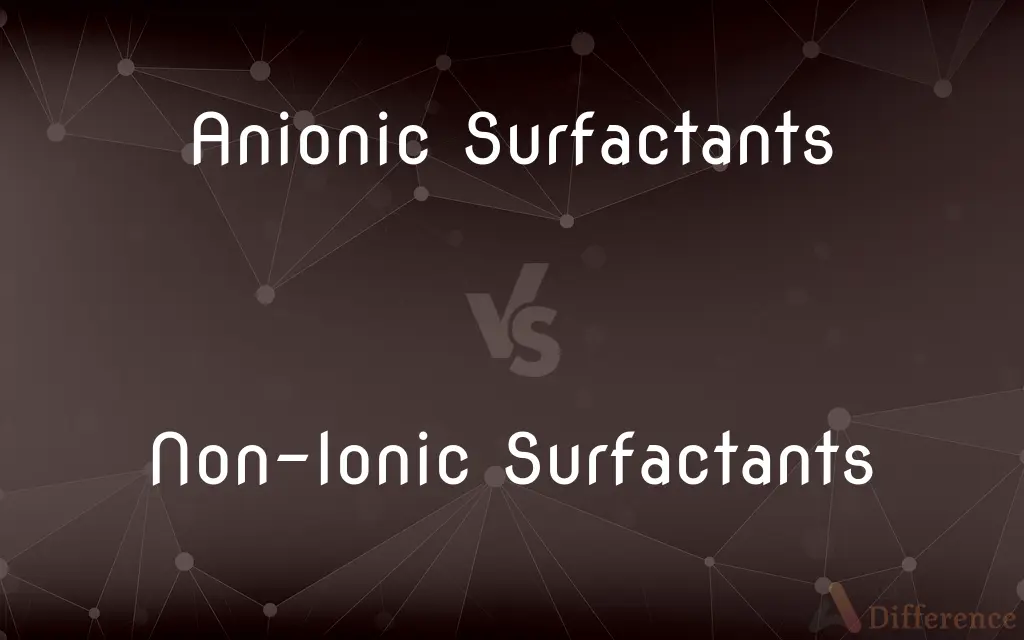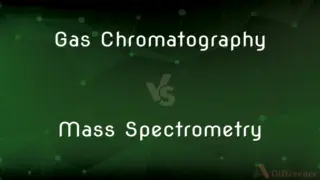Anionic Surfactants vs. Non-Ionic Surfactants — What's the Difference?
By Fiza Rafique & Urooj Arif — Published on February 20, 2024
Anionic surfactants carry a negative charge, ideal for detergents and soaps. Non-ionic surfactants have no charge, making them gentle and less reactive with hard water.

Difference Between Anionic Surfactants and Non-Ionic Surfactants
Table of Contents
ADVERTISEMENT
Key Differences
Anionic surfactants and non-ionic surfactants are two classes of surface-active agents, differing primarily in their ionic properties and applications. Anionic surfactants possess a negative charge on their hydrophilic (water-attracting) heads, which makes them highly effective in removing dirt and stains from fabrics and surfaces. Commonly found in laundry detergents, dishwashing liquids, and shampoos, anionic surfactants are known for their excellent cleaning properties and ability to create a significant amount of foam.
Non-ionic surfactants, on the other hand, do not carry any charge on their hydrophilic heads. This lack of charge reduces their reactivity with minerals found in hard water, making them more suitable for use in conditions where water hardness is a concern. Non-ionic surfactants are characterized by their mildness and are frequently used in personal care products, such as lotions and creams, as well as in certain household cleaners where gentleness is desired.
The key difference between these surfactants lies in their interaction with water and other substances. Anionic surfactants tend to be more aggressive in their action, making them highly effective for heavy-duty cleaning tasks. However, this can also lead to potential skin irritation in sensitive individuals. Non-ionic surfactants, with their gentler nature, are less likely to cause irritation, making them preferred for use in cosmetics and personal care products.
The effectiveness of anionic surfactants can be diminished in hard water due to the formation of insoluble salts, whereas non-ionic surfactants maintain their effectiveness regardless of water hardness. This makes non-ionic surfactants more versatile in a wider range of water conditions.
While both anionic and non-ionic surfactants play crucial roles in cleaning and personal care formulations, their distinct chemical properties make them suitable for different applications. Anionic surfactants are favored for their strong cleaning power, while non-ionic surfactants are valued for their mildness and versatility, especially in formulations where skin sensitivity and water hardness are considerations.
ADVERTISEMENT
Comparison Chart
Charge
Negative
No charge
Applications
Laundry detergents, dish soaps, shampoos
Lotions, creams, gentle cleaners
Water Hardness Reactivity
Reacts with minerals, less effective in hard water
Maintains effectiveness in hard water
Cleaning Power
High, removes dirt and stains effectively
Milder, suitable for gentle cleaning
Skin Irritation Potential
Higher, can cause irritation in sensitive individuals
Lower, generally considered gentler
Compare with Definitions
Anionic Surfactants
Surfactants with a negative charge.
Anionic surfactants are key ingredients in most household detergents.
Non-Ionic Surfactants
Used in a variety of gentle cleaning agents.
Many baby shampoos contain non-ionic surfactants.
Anionic Surfactants
May interact adversely with hard water.
Hard water can reduce the cleaning efficiency of anionic surfactants.
Non-Ionic Surfactants
Effective in hard water conditions.
Unlike anionic surfactants, non-ionic ones work well even in hard water.
Anionic Surfactants
Effective in removing oils and dirt.
Anionic surfactants excel in breaking down grease on dishes.
Non-Ionic Surfactants
Less likely to cause skin irritation.
For sensitive skin, products with non-ionic surfactants are recommended.
Anionic Surfactants
Common in personal and home cleaning products.
From body wash to laundry detergent, anionic surfactants are everywhere.
Non-Ionic Surfactants
Surfactants without any electrical charge.
Non-ionic surfactants are preferred for their mildness in skincare products.
Anionic Surfactants
Known for creating a lot of foam.
The foam in your shampoo is thanks to anionic surfactants.
Non-Ionic Surfactants
Stable in a wide pH range.
Non-ionic surfactants are stable and effective across different pH levels.
Common Curiosities
Why are anionic surfactants used in detergents?
Their negative charge and foam-producing ability make them effective in cleaning.
Are anionic surfactants bad for the environment?
They can be, if not properly treated before disposal.
Are non-ionic surfactants better for hard water areas?
Yes, because their effectiveness is not diminished by minerals in hard water.
Why are non-ionic surfactants preferred in cosmetics?
Their gentleness and lower irritation potential make them suitable for sensitive skin.
Do anionic surfactants work in cold water?
Yes, they are effective in both cold and hot water.
Can using products with anionic surfactants cause skin irritation?
Yes, especially in individuals with sensitive skin.
What makes anionic surfactants effective in cleaning?
Their ability to interact with and remove dirt and organic materials.
What are surfactants?
Compounds that lower the surface tension between two substances, such as oil and water.
Can non-ionic surfactants remove grease?
Yes, but they are generally milder compared to anionic surfactants.
Do non-ionic surfactants produce foam?
They can, but generally less than anionic surfactants.
Are anionic surfactants found in all shampoos?
Many, but not all, as some are formulated with non-ionic or amphoteric surfactants for gentleness.
How are surfactants chosen for cleaning products?
Based on the product's intended use, desired properties (like foam level), and the need for mildness.
How do I know if a product contains non-ionic surfactants?
Ingredients such as laureth-9 or decyl glucoside indicate non-ionic surfactants.
Can I avoid skin irritation by using non-ionic surfactant-based products?
They are less likely to cause irritation, making them a better choice for sensitive skin.
Is it safe to mix anionic and non-ionic surfactants?
Yes, and doing so can combine the benefits of both in cleaning products.
Share Your Discovery

Previous Comparison
Sustainability vs. Sustainable Development
Next Comparison
Gas Chromatography vs. Mass SpectrometryAuthor Spotlight
Written by
Fiza RafiqueFiza Rafique is a skilled content writer at AskDifference.com, where she meticulously refines and enhances written pieces. Drawing from her vast editorial expertise, Fiza ensures clarity, accuracy, and precision in every article. Passionate about language, she continually seeks to elevate the quality of content for readers worldwide.
Co-written by
Urooj ArifUrooj is a skilled content writer at Ask Difference, known for her exceptional ability to simplify complex topics into engaging and informative content. With a passion for research and a flair for clear, concise writing, she consistently delivers articles that resonate with our diverse audience.
















































